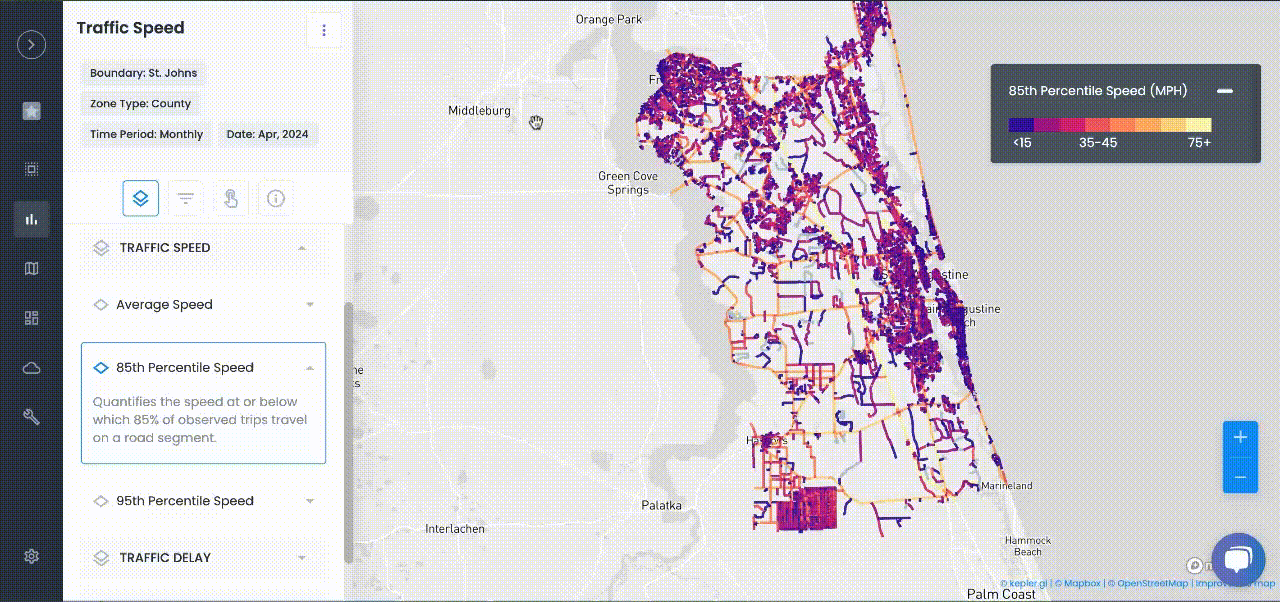
Transportation Planning
3D Road Geometry Mapping: Why It Matters for Future Infrastructure Projects
How 3D road geometry mapping with AI and satellite imagery helps cities plan smarter, faster, and more accurate infrastructure projects
Discover how 3D road geometry mapping with AI and satellite imagery helps cities plan smarter, faster, and more accurate infrastructure projects.
Future infrastructure projects – from new highways to smart city upgrades – rely on accurate data. One emerging tool providing that accuracy is 3D road geometry mapping. Unlike traditional 2D maps that give a flat view of roads, 3D mapping captures the third dimension (elevation and depth) to create a realistic model of roadways. This richer map of the road network is helping city planners, transportation engineers, and public sector decision-makers visualize projects more clearly and plan with greater confidence.
Let’s explore how 3D road geometry mapping works, what advantages it offers in precision, visualization, and data richness, and why it is key to building future-ready infrastructure – using Urban SDK’s innovative approach as an example.
What is 3D Road Geometry Mapping (and How is it Different from 2D)?
3D road geometry mapping is the process of creating a three-dimensional digital model of roadways, including not just their horizontal layout but also elevation, slope, and other physical details. In simple terms, a 2D road map might show the layout of streets on a flat plane, whereas a 3D road map includes the vertical dimension – capturing hills, overpasses, and the nuances of a road’s shape in the real world. By incorporating depth, 3D mapping provides a more realistic and detailed view of roads and infrastructure than traditional flat maps ever could.
For example, a 2D plan of a highway interchange shows the layout, but a 3D map also depicts each ramp’s height and slope, ensuring the design works with the terrain – not just on paper. In short, 2D mapping offers a blueprint, while 3D mapping creates a lifelike model of the road network that can be examined from any angle.
From Traditional Surveys to AI-Powered Mapping
Gathering road data used to require slow, costly manual surveys with crews measuring each street. Some agencies later tried mobile mapping vehicles – vans with cameras or LiDAR scanners – which sped up collection but still needed extensive processing and expensive hardware. Today, AI-powered 3D mapping uses aerial and satellite imagery with machine learning to automatically detect road features and geometry from above, covering entire cities faster than any ground team. Urban SDK processes high-resolution satellite photos to identify lane markings, signs, curbs, sidewalks, and other attributes at scale – and produces a scalable, up-to-date 3D map of the road network whenever new imagery is available. In one pilot, this AI mapping cataloged sidewalks 45 times faster than traditional methods.
Key Advantages of 3D Road Mapping
Moving from flat diagrams to detailed 3D road models offers clear benefits for cities. Here are key advantages in terms of precision, visualization, and data richness (along with gains in efficiency):
Greater Precision & Accuracy: 3D mapping provides exact measurements of road dimensions and elevations. Automated AI systems apply the same logic to every road segment, ensuring consistent data quality while catching subtle details (like slight grade changes or faded markings) that human surveyors might overlook. Some AI-driven inspection tools even operate at highway speeds with accuracy comparable to on-site surveys.
Enhanced Visualization: With a 3D road model, planners and stakeholders can visualize infrastructure projects in context. Instead of deciphering abstract lines on a flat map, they see a realistic view of how new roads or changes will look in the real world. Sharing these visuals makes it much easier to communicate plans to the public and officials, leading to greater understanding and support for projects.
Richer Data & Context: A 3D road map isn’t just a shape of the pavement – it comes with a wealth of associated information. Modern systems can extract details like number of lanes, road width, surface type, presence of bike lanes or sidewalks, and locations of signs or signals. All these attributes provide context that a simple 2D map wouldn’t show, so planners can consider every facet of the roadway and avoid overlooking critical details during design.
Efficiency & Timeliness: Automating road mapping with AI dramatically reduces the time and cost needed for data collection. One city saved over $80,000 by replacing a multi-year ground survey with an AI-powered inventory; what once took months can now be done in weeks, and frequent satellite updates mean planners are always working with current information.
Smarter Planning and Better Design
All these advantages lead to smarter planning and better design outcomes. When planners have a precise, 3D snapshot of the road network, they can make more informed decisions with confidence. There’s less guesswork because the data shows exactly what exists on the ground.
For instance, when redesigning a complex intersection, a 3D map shows each road’s approach angle, elevation and sightlines – so engineers can spot problems like poor visibility or steep grades in advance, before they turn into costly construction issues. By catching design conflicts early, cities can avoid rework and improve the final quality of projects.
A detailed 3D map also improves communication. When planners share realistic 3D visuals of proposed changes, it’s easier for non-engineers to grasp the project’s impact and provide input. This leads to designs that better reflect community needs and earn public support.
Moreover, 3D road mapping supports proactive planning. With a complete, current inventory of road assets and conditions, cities can better prioritize maintenance and improvements. They can quickly see where interventions (repaving, adding bike lanes or crosswalks) are most needed, leading to more efficient and equitable use of resources. Importantly, 3D data also enhances safety planning. Accurate road geometry and signage data can feed into traffic models to predict high-risk areas. With these insights, planners can proactively include safety measures (such as improved signage or pedestrian protections) in project designs, making new infrastructure safer immediately.
Urban SDK’s Role: AI and Satellite Powering 3D Mapping
Urban SDK has emerged as a key enabler of 3D road geometry mapping. The platform uses AI algorithms and satellite imagery to map road networks in detail without needing large ground survey crews. Urban SDK’s Roadway Characteristics product delivers detailed 3D road geometry and related attributes (like lane counts, widths, and sidewalks) from recent imagery. Users can explore this rich dataset through an interactive dashboard.
By automatically recognizing road features in imagery, Urban SDK greatly reduces the time required for roadway inventories. It shrinks years of manual work into hours, allowing staff to focus on planning rather than data collection. Cities have also saved tens of thousands of dollars by choosing AI mapping over traditional surveys. While some other solutions rely on vehicles with dash cameras or laser scanners, Urban SDK stands out by capturing road data at a broad scale from overhead imagery. This means even large or hard-to-survey areas can be mapped quickly and consistently.
Urban SDK also outputs its 3D road data in formats compatible with existing city GIS tools, so planners can import it directly into their systems. This gives agencies a faster, smarter way to keep road information up to date and make data-driven decisions.
Conclusion: Mapping the Road Ahead
As cities gear up for the next generation of infrastructure projects, having an accurate, current map of road geometry is increasingly essential. 3D road geometry mapping provides the foundation for these future projects by offering precision, clarity, and data depth far beyond what legacy 2D maps can provide. With detailed 3D road models, planners can design smarter, avoid costly mistakes, and ensure new infrastructure fits its environment seamlessly.
AI-powered platforms Urban SDK show that maintaining a live 3D road inventory is now both feasible and cost-effective, providing officials a faster, more affordable, and more effective way to manage road networks. In summary, 3D road geometry mapping matters for future infrastructure projects because it equips cities with better data for better decisions. This technology turns a slow, labor-intensive surveying chore into an automated, insight-rich process. City planners and engineers can devote more energy to designing and strategizing, confident that their underlying data is reliable and up-to-date. Ultimately, embracing 3D mapping today means building safer, more efficient, and future-ready infrastructure
FAQs
Q1: What is 3D road geometry mapping and how is it different from traditional 2D mapping?
Ans: 3D road geometry mapping creates precise digital models of roadways with elevation, slope, and physical details, while 2D maps only show road layouts on a flat plane. 3D mapping incorporates vertical information, providing a realistic, lifelike model that supports better planning and design decisions.
Q2: What advantages does 3D road mapping provide for city planners and engineers?
Ans: 3D mapping delivers greater measurement precision, consistency, and context - capturing changes in grade, overpasses, and engineering nuances. It enables enhanced visualization for communication, helps spot design issues (like poor sightlines), and provides comprehensive data on lanes, widths, signage, and sidewalks.
Q3: How does Urban SDK use AI and satellite imagery for 3D mapping?
Ans: Urban SDK’s platform processes high-resolution satellite and aerial imagery with machine learning to detect road features, lane markings, signs, sidewalks, curbs, and more across an entire city. This automated approach produces a scalable, accurate 3D map much faster and more affordably than ground surveys.
Q4: What data can 3D road geometry mapping deliver for infrastructure projects?
Ans: Along with 3D geometry, Urban SDK’s maps include lane counts, widths, road surface type, curb and sidewalk dimensions, bike lanes, signage, parking, medians, and asset condition - all formatted for use in city GIS and infrastructure planning systems.
Q5: How does 3D mapping support smarter, faster, and more efficient project delivery?
Ans: Automation drastically reduces data collection times, enables frequent updates for real-time accuracy, and helps teams avoid costly design errors or rework. 3D visuals can also engage the public and decision-makers, building support for projects.
Q6: Can 3D mapping help cities prioritize upgrades, maintenance, and safety?
Ans: Yes - comprehensive 3D road inventories highlight where improvements are most needed, support predictive maintenance, and boost proactive safety analysis (such as detecting risky curves or missing signage), leading to fairer and more effective allocation of resources.
Q7: How does Urban SDK’s 3D road geometry data fit with existing city technology?Ans: Urban SDK delivers GIS-compatible, planning-ready datasets that integrate directly with city asset management, simulation, and mapping tools. This seamless workflow accelerates project development and keeps infrastructure databases current.

TRAFFIC ENFORCEMENT FEATURES
80% of citizen complaints
are a perception problem
Urban SDK provides precise hourly speed data to evaluate complaints and deploy resources efficiently for the greatest impact to public safety.
Urban SDK provides precise hourly speed data to evaluate complaints and deploy resources efficiently for the greatest impact to public safety.
Target Speeding
Identify hot spots, validate monthly speeding trends and monitor vulnerable areas like school zones.
Improve Safety
Crash and citations location information to compare speed trends month over month
Fast Response
Respond to citizen complaints sooner with address search and exportable reporting
Deploy Assets
Generate maps for traffic enforcement by time of day, location or division to deploy officers to known problem areas.
RESOURCES
Customer Success
See how public sector leaders succeed with Urban SDK.
WEBINAR
Identify speeding and proactively enforce issues
See just how quick and easy it is to identify speeding, address complaints, and deploy officers.







